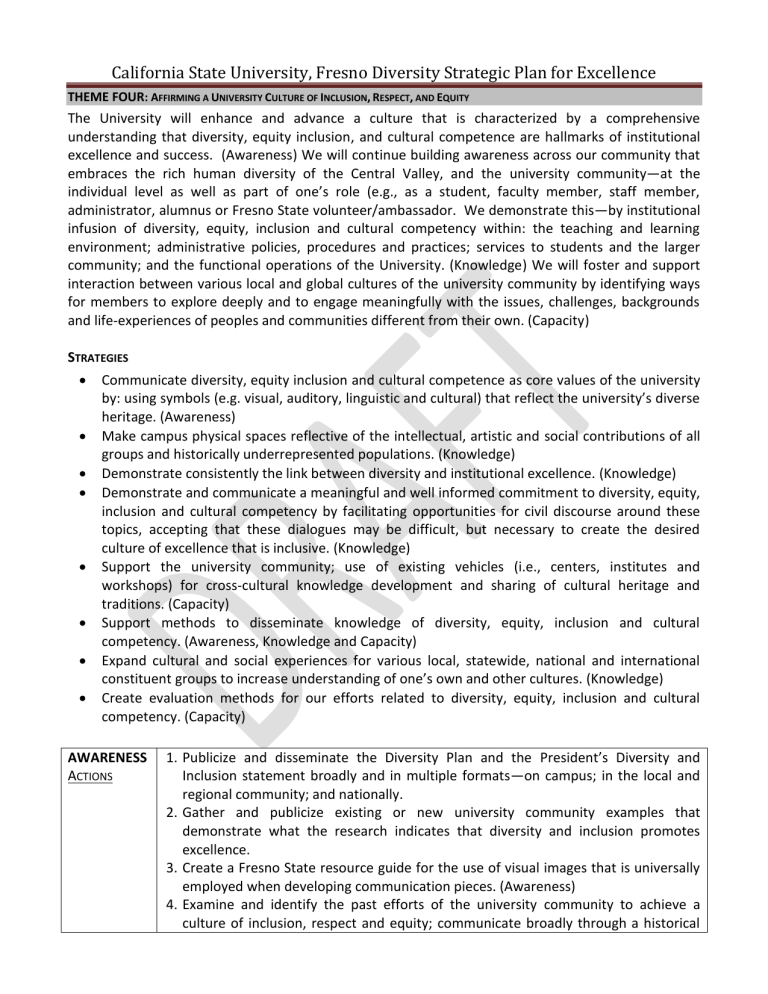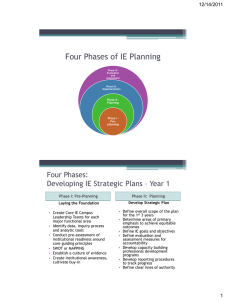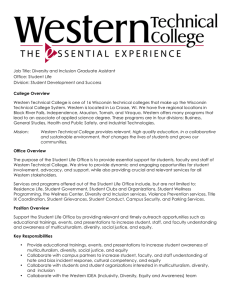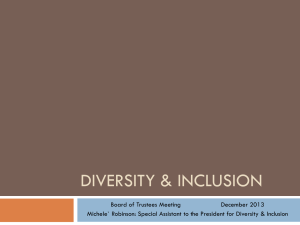California State University, Fresno Diversity Strategic Plan for Excellence

California State University, Fresno Diversity Strategic Plan for Excellence
THEME FOUR : A FFIRMING A U NIVERSITY C ULTURE OF I NCLUSION , R ESPECT , AND E QUITY
The University will enhance and advance a culture that is characterized by a comprehensive understanding that diversity, equity inclusion, and cultural competence are hallmarks of institutional excellence and success. (Awareness) We will continue building awareness across our community that embraces the rich human diversity of the Central Valley, and the university community—at the individual level as well as part of one’s role (e.g., as a student, faculty member, staff member, administrator, alumnus or Fresno State volunteer/ambassador. We demonstrate this—by institutional infusion of diversity, equity, inclusion and cultural competency within: the teaching and learning environment; administrative policies, procedures and practices; services to students and the larger community; and the functional operations of the University. (Knowledge) We will foster and support interaction between various local and global cultures of the university community by identifying ways for members to explore deeply and to engage meaningfully with the issues, challenges, backgrounds and life-experiences of peoples and communities different from their own. (Capacity)
S TRATEGIES
Communicate diversity, equity inclusion and cultural competence as core values of the university by: using symbols (e.g. visual, auditory, linguistic and cultural) that reflect the university’s diverse heritage. (Awareness)
Make campus physical spaces reflective of the intellectual, artistic and social contributions of all groups and historically underrepresented populations. (Knowledge)
Demonstrate consistently the link between diversity and institutional excellence. (Knowledge)
Demonstrate and communicate a meaningful and well informed commitment to diversity, equity, inclusion and cultural competency by facilitating opportunities for civil discourse around these topics, accepting that these dialogues may be difficult, but necessary to create the desired culture of excellence that is inclusive. (Knowledge)
Support the university community; use of existing vehicles (i.e., centers, institutes and workshops) for cross-cultural knowledge development and sharing of cultural heritage and traditions. (Capacity)
Support methods to disseminate knowledge of diversity, equity, inclusion and cultural competency. (Awareness, Knowledge and Capacity)
Expand cultural and social experiences for various local, statewide, national and international constituent groups to increase understanding of one’s own and other cultures. (Knowledge)
Create evaluation methods for our efforts related to diversity, equity, inclusion and cultural competency. (Capacity)
AWARENESS
A CTIONS
1.
Publicize and disseminate the Diversity Plan and the President’s Diversity and
Inclusion statement broadly and in multiple formats—on campus; in the local and regional community; and nationally.
2.
Gather and publicize existing or new university community examples that demonstrate what the research indicates that diversity and inclusion promotes excellence.
3.
Create a Fresno State resource guide for the use of visual images that is universally employed when developing communication pieces. (Awareness)
4.
Examine and identify the past efforts of the university community to achieve a culture of inclusion, respect and equity; communicate broadly through a historical
KNOWLEDGE
A CTIONS
C
A
APACITY
CTIONS timeline the successes, the setbacks and the lessons learned to inform future efforts.
5.
Identify various settings (integrating artwork and signage in common areas such as critical points of entry and high-usage spaces) that reflect the diversity of the university and region and develop communication venues that promote the campus history, inclusion statement, diversity plan, and action steps in ways that stimulate the university community to engage in implementing the actions (e.g., the university website, on- and off-campus community forums, blogs, pamphlets, SKYPE groups, exhibits, a history walk/wall, TV and radio interviews, presentations at national conferences focused on diversity, equity, inclusion and cultural competence as well as conferences hosted by academic disciplines that focus on inclusive teaching practices).
1.
Create and support teaching and learning communities made up of faculty, students, staff and administrators, or all constituent groups to provide opportunities for exploring the development of cultural competence (i.e., understanding multicultural ways of being, thinking, acting) formally through empirical quantitative and qualitative research; and informally through civil discourse, difficult dialogue and guided reflection; as well as support for in-residence programs for national and international artists.
2.
Identify and implement a wide variety of methods to encourage broad participation in campus events that facilitate international and cross-cultural engagement and accelerate cultural understanding including, but not limited to: adequate resources to ensure that the events have broad appeal; greater faculty involvement in planning and execution; more intentional linkages to the curriculum; highlight and celebrate regional visual and performing artists through campus events; and senior leadership advocacy.
3.
Develop and implement diversity, equity and inclusion orientation programs that lay a foundation for the expectation of cultural competence by all members of the university community, which outlines how cultural competency is demonstrated in various roles and responsibilities and how each university community member is to be held accountable. Examples include: LEAD programming; mentorship and leadership development programs; faculty and student development programs, alumni engagement, and volunteer/ambassador orientation programs.
4.
Develop learning guides (in multiple languages) regarding the available campus/community resources that are designed to address the unique needs of various groups (e.g., racial/ethnic, religious, gender, sexual identity, ability).
5.
Establish a recognition program that recognizes exemplary contributions by community and campus members (student, faculty, staff and administrators) to create a culture that embraces diversity, equity, inclusion and cultural competency.
6.
Hold university community members at all levels accountable for fostering a culture that embraces diversity, inclusion and cultural competence and establishing equitable practices within their sphere of influence.
1. Establish a campus-wide mechanism to highlight teaching, learning and/or community practices that: create a climate of civility, inclusion, and respect for diversity; and foster deep understanding and meaningful engagement with
T HEME F OUR 2 T HEME F OUR
differences and commonalities in populations and their life experiences.
2. Examine the structure of student organizations outreach and programming to ensure equitable support is given to student organizations that offer university community events that facilitate cross-cultural engagement is equitable.
3. Establish and encourage the use of universal design and other alternative methods of accessing, using and disseminating knowledge and enhanced communications for the entire campus (e.g., resources for interpreting services; American Sign Language and foreign languages; auditory and translation devices; critical university activities, functions or communication pieces in multiple languages).
4.
Establish a procedure for planning accessible campus events in which the population exceeds 100.
5. Facilitate the development of and provide support for faculty/staff associations (aka employee resource groups—ERGs) based on self-proclaimed identity, interests, backgrounds and diverse and embed mentorship dimensions within them for the purpose of knowledge development and organizational effectiveness.
6. Conduct an analysis of resource allocations for various campus diversity initiatives to ensure the appropriate level of support is provided across the university community.
7. Conduct a campus climate survey to establish a baseline of community member’s perceptions of diversity, equity, inclusion and cultural competence at Fresno State and to determine how the institution may advance its goals for diversity and inclusion.
8. Establish or designate a position(s) to work with the PCHRE to oversee all areas of diversity, equity, inclusion and cultural competence recognizing that the position should be one that provides leadership, managerial support and guidance for the work of the diversity plan similar to the way that senior leaders offers guidance for the strategic plan process and strategic initiatives—it is a responsibility that is shared with many others who are also held accountable for the outcomes.
I NDICATORS (UNDER DEVELOPMENT)
1.
Equitable artistic representations of the broad diversity of the campus community—especially of historically underrepresented populations—are more evident in common spaces as judged by various climate surveys. (Awareness)
2.
The number of people who attend cultural knowledge events and recognize the role of diversity in the learning experience increases as indicated through periodic climate surveys. (Awareness)
3.
Increased visits by students, community and faculty to redesigned spaces for exploration and engagement with diversity.
4.
Increased number of local and campus community members who are aware of and participate in the university- sponsored cross-cultural interactions facilitated both on- and off-campus.
(Awareness/Knowledge)
5.
Create expectations to respect cultural differences at all levels of the university community.
(Knowledge)
6.
Results of the campus climate survey guide and evolve the efforts represented in this and future plans as judged by subsequent climate surveys indicating improvement and correlational/causal links are made to the action items of the plan(s). (Capacity)
T HEME F OUR 3 T HEME F OUR
7.
Student success indicators across various population groups are equitable (e.g., 4- and 6-year graduation rates, STEM majors, gateway courses) and are comparable or better than peer
Hispanic Serving Institutions (HSIs), Asian American and Native American Pacific Islander
Serving Institution (AANAPISI) and other Minority Serving Institutions (MSIs). (Capacity)
8.
Staffing patterns of historically underrepresented racial and ethnic populations compare favorably with a list of peer Hispanic Serving Institutions (HSIs), Asian American and Native
American Pacific Islander Serving Institution (AANAPISI) and other Minority Serving Institutions
(MSIs). (Capacity)
T HEME F OUR 4 T HEME F OUR


